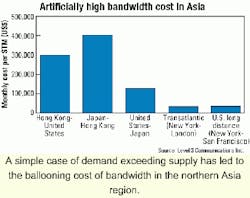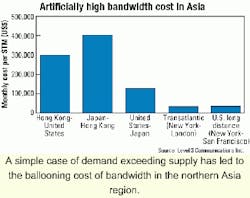FLAG Telecom, Level 3 to deliver capacity to northern Asia
By MEGHAN FULLER
Pent-up demand for bandwidth in the northern Asia region has caused the cost of existing bandwidth to skyrocket, forcing Internet service providers (ISPs) to allocate a huge portion of their operating expenses-typically between 30% and 50%-on bandwidth. To satiate this demand, two like-minded carriers' carriers, FLAG Telecom (London) and Level 3 Communications Inc. (Broomfield, CO), have pooled their resources to build a multiterabit, intra-Asia submarine cable system targeted at four high-traffic centers in the region: Tokyo, Hong Kong, Seoul, and Taipei.
The combined capacity of the three existing systems in the northern Asia region is just under 100 Gbits-which doesn't come close to meeting demand, says FLAG Telecom chief operating officer Ed McCormack. As a result, the cost of capacity on a transpacific link from Hong Kong to the United States or from Japan to the United States is eight to 10 times greater than the cost of the same capacity on a transatlantic link.Moreover, "the price [of capacity] from Hong Kong to Japan is more expensive than Hong Kong to the U.S.," explains Weichou Su, Level 3's managing director for Hong Kong and China. "That's just ridiculous. If you look at the distance, it's very short. The new submarine cable [system] will really help this situation."
The 10,000-km DWDM system will dramatically increase capacity from day one, says McCormack, as it will deliver "an order of magnitude greater than the capacity available in the region at the moment."
Level 3's existing North Asia Cable System (NACS), connecting Hong Kong, Taiwan, and Japan, will form the eastern leg of the new system. A joint bid between Alcatel (Paris) and Fujitsu (Tokyo), NACS is a 42-wavelength, six-fiber-pair system that begins operation next quarter at 10 Gbits/sec. It is upgradable to 2.56 Tbits. Level 3 will increase capacity according to market demand, says Su.
FLAG Telecom is responsible for the western leg, which will stretch from Wada, Japan to Pusan, South Korea, then from Pusan down to Hong Kong at Lantau Island, a total span of about 5,000 km. The landings at Wada and Lantau Island are common to NACS, as well, forming the complete ring. Built entirely by Alcatel, the western leg is a six-fiber-pair, 64-wavelength system. Branded the FLAG North Asian Loop (FNAL), it will enter operation at 10 Gbits/sec but is fully upgradable to 3.8 Tbits.
The system, says McCormack, has been designed to support next-generation Internet Protocol (IP) networking. "We believe the next-generation of Internet networks will be built on an entirely optical-core network," he ex plains. "So we're going to be providing access to optical wavelengths, or colors, directly for all of our customers so they can essentially do IP-over-DWDM Internet networking."
The total cost of the system is estimated at $900 million and will be shared by the two carriers. FLAG Telecom and Level 3 entered into the relationship "both of like mind," says McCormack, with the mutual goal of providing their customers with low-cost capacity as quickly as possible.
Level 3's Su agrees. "They share our vision about the growth of the market, about where the growth is, and where it will be," he asserts. "That's why we said, 'These are the four markets we want to reach, too, so let's work together.'"Shared fiber rings also make sense from a technological standpoint. "They will have a fully protected ring, as opposed to just having the point-to-point systems that they would have had if they had just been on their own," explains Daniel McKeage, commercial manager at Alcatel, the vendor responsible for the design, manufacture, and installation of the western leg. "And they have done this in a way that has shortened their time-to-market scales, as well," he adds.
Target customers within the region include ISPs, data centers, the major IP players, and particularly local carriers. International carriers and multinational companies have also shown interest in the system. Both legs of the network will include seamless links to other cable systems in Europe and the United States.
"We expect to link [FNAL] to FLAG Pacific-1, a transpacific cable," says Andy Evans, executive vice president of strategy at FLAG Telecom. "Really, this is very supportive of our overall strategy of completing a global network and rolling out a range of products and services over that." The link with the FLAG Pacific-1 system is scheduled for completion in 2002.
Level 3 has plans to link its portion of the network, nicknamed Tiger, to the United States via the Japan-U.S. Cable Network, of which it is the second largest owner. "Most of the demand-in Hong Kong at least-is really for the U.S.," says Su.
The eastern segment landed in Hong Kong last December and is now making its way to Japan. The landings in Korea and Taiwan will be completed by the end of this year. The eastern leg should be ready for operation in 2002 with the rest of the network gradually phased into operation thereafter, barring any unforeseen obstacles.
The process to get a license and a permit to lay cable in Asia is complicated at best, but Su is confident that it won't be a major obstacle. "We went through that process [with NACS]. We applied to the government, the government put our application on the public register for people to comment or to raise objections. Our cable system went through very smoothly," he says, adding that Level 3 was the first applicant permitted to bring capacity from outside Hong Kong into Hong Kong.
From a manufacturer's point of view, the biggest challenge is environmental, admits McKeage. The cable must be armored or buried to protect it from minor third-party aggressions. "There's a lot of fishing activity in that area," he explains, "and ships anchor closer in shore." About 50% of the cable will be armored, which involved wrapping it in various grades of steel wires, depending on the potential danger from external aggressions.

